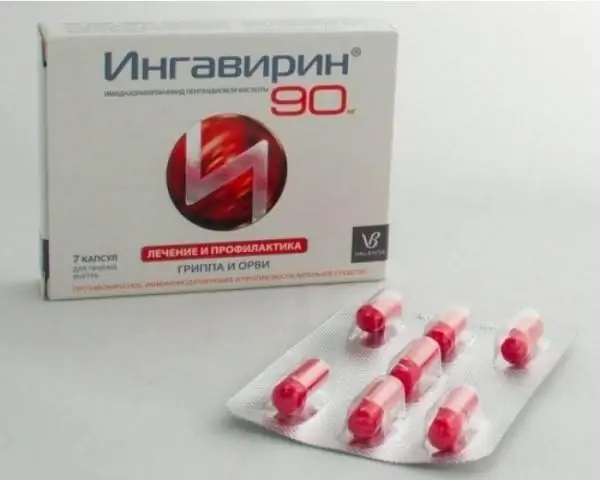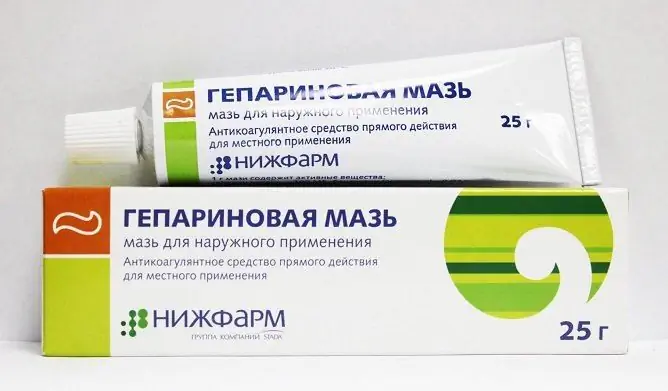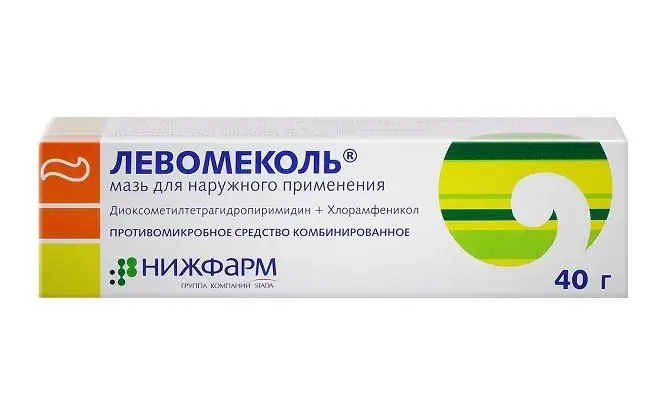- Author Rachel Wainwright [email protected].
- Public 2023-12-15 07:39.
- Last modified 2025-11-02 20:14.
Lorinden S
Lorinden S: instructions for use and reviews
- 1. Release form and composition
- 2. Pharmacological properties
- 3. Indications for use
- 4. Contraindications
- 5. C, Method of application and dosage
- 6. Side effects
- 7. Overdose
- 8. Special instructions
- 9. Application during pregnancy and lactation
- 10. Use in childhood
- 11. Drug interactions
- 12. Analogs
- 13. Terms and conditions of storage
- 14. Terms of dispensing from pharmacies
- 15. Reviews
- 16. Price C in pharmacies
Latin name: Lorinden C
ATX code: D07BB01
Active ingredient: clioquinol (Clioquinol) + flumethasone (Flumetasone)
Producer: Pharmaceutical Works Jelfa, SA (Poland)
Description and photo update: 2019-02-09
Prices in pharmacies: from 323 rubles.
Buy

Lorinden S is an external preparation with antimicrobial, antipruritic, anti-allergic and anti-inflammatory effects.
Release form and composition
The drug is produced in the form of an ointment: oily, white with a gray or light yellow tint (in aluminum tubes of 15 g, in a cardboard box 1 tube and instructions for use of Lorinden C).
The composition of 100 mg ointment contains active substances:
- Flumethasone pivalate - 0.02 mg;
- Clioquinol - 3 mg.
Auxiliary components: white beeswax - 1 mg, petroleum jelly - up to 100 mg.
Pharmacological properties
Pharmacodynamics
Lorinden S is a combined external preparation with antibacterial, anti-inflammatory and antifungal effects.
Flumethasone is a synthetic bifluorinated glucocorticosteroid for external use. It has antiallergic, anti-inflammatory, antipruritic, vasoconstrictor and anti-edema effect. When applied externally, it prevents the regional accumulation of neutrophils, this helps to reduce the inflammatory exudate and production of lymphokines, slow down the processes of infiltration and granulation, and inhibit the migration of macrophages. Reduces the production of prostaglandins and leukotrienes, which occurs due to inhibition of the activity of phospholipase A 2and reducing the release of arachidonic acid from the phospholipids of the cell membrane. It is an inhibitor of cellular kinins, which have proteolytic activity. It causes a reduction in the basic substance of connective tissue, helps to weaken exudative and proliferative reactions in the skin.
Clioquinol (iodochloroxyquinoline) is a derivative of 8-hydroxyquinolines. Shows activity against dermatophytes, yeast fungi (Trichophyton spp., Microsporum spp., Candida albicans) and gram-positive bacteria (Enterococcus spp., Staphylococcus spp.). Strengthens the antiexudative effect of flumethasone.
Due to the combined action of the two components, Lorinden C helps to suppress the development of inflammatory and allergic skin reactions, which are complicated by fungal and bacterial infections.
The ointment has a greasy base, which has a softening and water-repellent effect, forms a protective film that protects the skin from external moisture. Also, due to the peculiarities of the ointment base, Lorinden C can be used in patients with thinned and dry skin.
Pharmacokinetics
When applied to the skin, the active components of Lorinden C easily penetrate the stratum corneum.
Flumethasone is practically not absorbed into the bloodstream and has no systemic effect. The absorption of a substance increases in the following cases:
- Frequent use of Lorinden C and / or its application to large areas of the skin;
- Application in the area of skin folds, on the face, on areas of the skin with damaged epidermis;
- Application under an occlusive dressing, which contributes to an increase in humidity and local temperature (the penetration of flumethasone into the deep layers of the skin under the occlusive dressing is approximately 100 times greater than with a simple application of the ointment to the affected areas).
In children, absorption of flumethasone from the skin is more pronounced than in adults.
Flumethasone is practically not metabolized in the skin. Metabolism after absorption occurs mainly in the liver. It is excreted in the urine and bile in the form of metabolites and, in small quantities, as an unchanged substance.
Clioquinol can be slightly absorbed through the skin and bind to blood plasma proteins. It undergoes partial biotransformation in the liver and is excreted in the urine.
Indications for use
Lorinden S ointment is prescribed for the treatment of the following allergic dermatoses complicated by a bacterial infection, which are caused by microorganisms sensitive to the action of the drug:
- Dermatitis, including seborrheic, occupational, solar, contact, allergic;
- Atopic dermatitis (common neurodermatitis);
- Psoriasis (especially old ones, including psoriasis of the scalp);
- Hives;
- Eczema;
- Erythroderma;
- Erythema multiforme;
- Pruritus;
- Dermatoses that do not respond to glucocorticosteroid therapy, including lichen planus, discoid lupus erythematosus;
- Secondary infections with insect bites.
Lorinden S is also used in the treatment of bacterial and fungal skin infections complicated by the development of local allergic reactions, including infected diaper rash, impetigo, dermatomycosis, blastomycosis, actinomycosis, sporotrichosis.
Contraindications
- Viral diseases of the skin, including chickenpox, herpes;
- Skin infections (for use with an occlusive dressing);
- Cutaneous manifestations of syphilis;
- Lupus;
- Perioral dermatitis;
- Pre-cancerous conditions and skin neoplasms (atheroma, nevus, skin cancer, melanoma, epithelioma, xanthoma, hemangioma, sarcoma);
- Acne (pink and vulgar);
- Trophic ulcers of the legs associated with varicose veins;
- Condition after vaccination;
- Age up to 10 years;
- I trimester of pregnancy;
- Hypersensitivity to drug components.
Lorinden C, if necessary, is used with caution in the II and III trimesters of pregnancy, as well as during breastfeeding.
Lorinden S, instructions for use: method and dosage
Lorinden C ointment is applied externally, applying a thin layer to the affected skin.
At the beginning of treatment, the drug is used up to 3 times a day, after improvement of the condition, the frequency of application is reduced to 1-2 times a day. The maximum dose is 2 g per day.
Do not use Lorinden C for more than 14 days.
If you need to apply an ointment with a bandage, you must use an air-permeable bandage. With hyperkeratosis and excessive lichenization, the ointment is used only under occlusive dressings 1 time in 24-48 hours. In these cases, the duration of therapy should not exceed 7 days.
In children over 10 years old, Lorinden C can be used only on limited areas of the skin in exceptional cases, avoiding the application of the drug on the skin of the face.
Side effects
- Systemic reactions: with prolonged therapy and / or use on large areas of the skin - disorders characteristic of the use of glucocorticosteroids;
- Local reactions: rarely - folliculitis, dry skin, itching, burning, striae, steroid acne; with prolonged therapy - purpura, local hirsutism, skin atrophy, telangiectasia, pigmentation disorders.
Overdose
Overdose cases of Lorinden C are rare. This is possible with incorrect, frequent or prolonged use of the ointment in significant volumes on large areas of the body.
Main symptoms: systemic side effects of glucocorticosteroids.
Therapy: gradual withdrawal of Lorinden C, symptomatic treatment.
special instructions
It is not recommended to apply Lorinden C on the skin of the face, and it is also necessary to avoid getting the ointment in the eyes.
The drug should not be used longer than the recommended period, since long-term use of Lorinden C in large areas increases the risk of systemic side effects of glucocorticosteroids.
With prolonged therapy, the development of microflora resistance to the action of the active substance of the drug (clioquinol) is possible.
In cases of the development of secondary infections at the site of application of the drug, it is necessary to use agents with a more pronounced antifungal or antibacterial effect.
With atrophic skin changes, especially in elderly patients, Lorinden C should be used with caution.
In case of fungal diseases with secondary allergic reactions, the ointment should be used under medical supervision in exceptional cases.
Application during pregnancy and lactation
In the first trimester of pregnancy, the use of Lorinden C is contraindicated.
Controlled studies of the possible teratogenic effect of topical application of the active components of the drug in pregnant women have not been conducted, therefore Lorinden C can be prescribed only in cases where the intended benefit to the mother is higher than the possible risk to the fetus.
It has not been established to what extent the active components of Lorinden C are excreted in breast milk when applied externally. If the appointment of the drug is necessary for lactating women, care must be taken, treatment should be carried out for a short time, only in exceptional cases, applying ointment to limited areas (excluding the area of the mammary glands).
Pediatric use
For patients under 10 years of age, the drug is not prescribed.
Drug interactions
Due to the immunosuppressive effect of Lorinden C, immunization and vaccination should not be carried out during therapy.
Simultaneous use with other external drugs is not recommended.
With the absorption of Lorinden C into the systemic circulation, the effectiveness of anticoagulants, antihypertensive drugs, insulin, oral hypoglycemic agents decreases, and the concentration of praziquantel and salicylates in the blood serum decreases.
With simultaneous use, the risk of side effects of estrogens, androgens, anticholinergics, oral contraceptives, anabolic steroids, antipsychotics, bucarban, tricyclic antidepressants, azathioprine, antihistamines, diuretics, nitrates, cardiac glycosides increases.
Analogs
Analogues of Lorinden C are: Flumethasone, Lorinden, Lorinden A, Dexamethasone, Prednisolone, Diprospan, Methylprednisolone.
Terms and conditions of storage
Keep out of reach of children at temperatures up to 25 ° C.
The shelf life is 3 years.
Terms of dispensing from pharmacies
Dispensed by prescription.
Reviews about Lorinden S
Reviews about Lorinden S are mostly positive. The product has a quick effect on many skin diseases and is well tolerated. The main disadvantage is considered a large list of contraindications.
Price for Lorinden S in pharmacies
The approximate price for Lorinden S (1 tube of 15 g) is 368-402 rubles.
Lorinden S: prices in online pharmacies
|
Drug name Price Pharmacy |
|
Lorinden S ointment for external use 15 g 1 pc. 323 r Buy |
|
Lorinden C ointment 15g 364 RUB Buy |

Anna Kozlova Medical journalist About the author
Education: Rostov State Medical University, specialty "General Medicine".
Information about the drug is generalized, provided for informational purposes only and does not replace the official instructions. Self-medication is hazardous to health!






